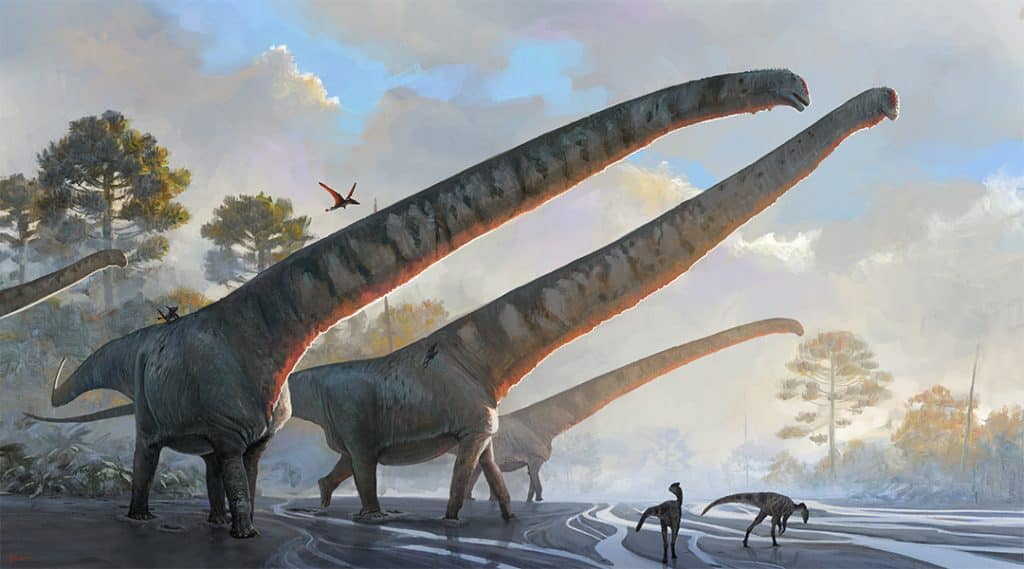
Scientists have uncovered an impressive new record in the dinosaur world. A team led by paleontologist Andrew J. Moore from Stony Brook University has discovered that Mamenchisaurus sinocanadorum, a Chinese sauropod from the Late Jurassic period, had a neck that measured a staggering 15 meters long (50 feet). This finding, published in the Journal of Systematic Palaeontology, sheds new light on the evolution of the sauropod body.
The gentle giants who once ruled Earth
Sauropods, the towering giants of the dinosaur world, have captivated people’s imagination ever since they were described in the mid-19th century. One of the most striking features of sauropods is their immense size. The largest sauropods, such as Argentinosaurus, could grow up to 30–35 meters (98–115 ft) in length and 60–75 tons in body mass. To support their massive bodies, sauropods had unique adaptations such as hollow bones and a lightweight, air-filled system of sacs and chambers within their bodies.
Sauropods also had some unique adaptations to their teeth and digestive systems. Rather than chewing their food, they swallowed it whole and relied on a series of fermentation chambers in their stomachs to break down tough plant material. Some sauropods even had specialized teeth that were shaped like spoons, which allowed them to scoop up large quantities of leaves and other vegetation.
But perhaps the most iconic feature of sauropods is their long necks. And Mamenchisaurus‘ neck was 15 meters long, the longest that can be confidently inferred for any known sauropod, according to Stony Brook University paleontologist Andrew J. Moore, lead author of the new study. For comparison, that’s six times longer than that of the longest-necked animals alive today, giraffes.
“All sauropods were big, but jaw-droppingly long necks didn’t evolve just once,” said Moore. “Mamenchisaurids are important because they pushed the limits on how long a neck can be, and were the first lineage of sauropods to do so. With a 15-meter-long neck, it looks like Mamenchisaurus sinocanadorum might be a record-holder — at least until something longer is discovered.”
Yet, despite their size, sauropods were able to move their necks with incredible precision, thanks to specialized joints and muscles that allowed them to reach high into trees to feed on vegetation. For sauropods, the long neck was crucial to achieving their iconic large body size. These animals had to be efficient at gathering food to power their massive bodies, and a long neck was perfectly suited for that task. By staying in one spot, they could hoover up surrounding vegetation, devouring tons of food while conserving precious energy by not moving their other body parts. In addition, having a long neck may have helped the sauropods shed excess body heat by increasing their surface area.
From the neck up

Mamenchisaurus new crowning as the longest-necked sauropod was no straightforward business. The first fossils were unearthed way back in 1987 in the Shishugou Formation in northwest China. Although the remains were incomplete, preserving the lower jaw, some bits of skull, and just a few vertebrae, it was plain to scientists that this dinosaur was huge when it roamed across marshy plains some 160 million years ago.
But other than that Mamenchisaurus was a sauropod and it must have been fairly large, the defining features of the dinosaur — chief among them being its neck — remained largely an enigma.
Over the years, no other fossils had turned up — something that wasn’t at all unexpected seeing how sauropod vertebrae are notoriously missing from the fossil record — but Mamenchisaurus was still on paleontologists’ radar.
Absent any new fossils, Moore and colleagues turned to the next best thing: other sauropods. The researchers analyzed several close relatives of Mamenchisaurus, including Xinjiangtitan, another sauropod discovered in China in 2013, which was remarkably found with its entire vertebral column. This specimen proved paramount, as it allowed the researchers to scale up the incomplete fossils of Mamenchisaurus.
The analysis suggests that out of all the included sauropods — and indeed out of all sauropods known thus far — Mamenchisaurus had the longest neck. This is a conclusion drawn from extrapolation rather than direct evidence, but the researchers are confident in their claims.
Like other sauropods, Mamenchisaurus‘ vertebrae were bird-like, with as much as 77% of their volume made up of air. Ribs in the neck overlapped on both sides of the neck, providing reinforcements to support the large load of the neck and skull.
“Biomechanical studies of the mamenchisaurid neck suggest that it was elevated at only a relatively shallow angle above the horizontal (20-30°). However, even at this relatively shallow angle, the extreme length of the neck would still mean that the animal’s head could reach heights of around 7.5 to 10 meters above ground level, facilitating feeding on tree foliage,” said co-author Paul Upchurch, a professor of palaeobiology from the University College London.
As for why Mamenchisaurus evolved such a long neck in the first place — even for a sauropod — scientists aren’t sure. The most likely factor is competition for food with other sauropods, which spurred the dinosaurs to grow increasingly longer necks to reach further up into canopies. At the same time, the dinosaur had to balance the long neck with certain requirements, such as circulating a lot of blood and allowing food to pass through it. This means there’s certainly a limit to how tall a sauropod can grow. We’ve yet to find that limit, but Mamenchisaurus surely pushed toward it.
The new findings were reported in the Journal of Systematic Palaeontology.






